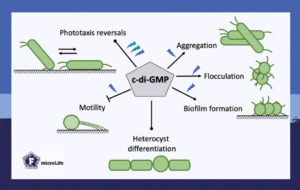Microorganisms experience fluctuations in many environmental factors, such as light, temperature, humidity and pressure. Cyanobacteria, like many other bacteria, base their adaptation to environmental stimuli on the intracellular concentrations of the molecule cyclic di-GMP (c-di-GMP), as outlined in the short review “Control of light-dependent behaviour in cyanobacteria by the second messenger cyclic di-GMP” in microLife. Gen Enomoto explains in the #FEMSmicroBlog how cyanobacteria integrate light into c-di-GMP signalling to ensure their survival. #FascinatingMicrobes
Cyanobacteria need light to grow and survive
Cyanobacteria are very important for life on Earth as they produce oxygen and chemical energy as the base of the food chain. For this, they use sunlight and carbon dioxide which is why they live in many different places on Earth where light is present.
While it is well understood how cyanobacteria use sunlight to grow, a lot is unclear about how they behave in nature. To adapt to environmental conditions, many bacteria, and as such cyanobacteria, rely on signal integration based on the nucleotide derivative cyclic di-GMP (c-di-GMP).
Most cyanobacteria species contain several genes encoding proteins that produce and degrade c-di-GMP. Since many of these proteins are directly coupled to sensing domains, cyanobacteria seem to be able to communicate various types of environmental information through c-di-GMP.
Recent studies have shown that c-di-GMP helps cyanobacteria adjust their physiology to different kinds of light. Acclimation to different light regimes is fundamental, as the efficiency of photosynthesis directly depends on the wavelength of the incoming light.
Furthermore, cyanobacteria have to adapt to the intensity of the sensed light. Energy from too much light results in the production of harmful reactive oxygen species. On the contrary, when light intensity is low, cyanobacteria need to extract as much energy as possible from the little light available.
Hence, both the quality and quantity of light matter for the survival and growth of photoautotrophic cyanobacteria.

Cyanobacteria avoiding blue light
The short review “Control of light-dependent behaviour in cyanobacteria by the second messenger cyclic di-GMP” in microLife focuses on what is known about how light affects c-di-GMP-dependent signalling in cyanobacteria. Since cyanobacteria require light for their survival, light seems to be the most crucial factor that determines their lifestyle and behaviour.
The review focuses on the two strains Thermosynechococcus vulcanus, living in hot springs, and Synechocystis sp. PCC 6803, isolated from a freshwater pond. Both these strains show interesting phototactic behaviour which they control through c-di-GMP signalling.
Blue light is the most harmful light in the visible spectrum. That’s why most cyanobacterial species respond to it by employing defence and protection mechanisms such as negative phototaxis and self-shading.
For example, upon sensing blue light, intracellular c-di-GMP levels increase in Thermosynechococcus and Synechocystis. This triggers Thermosynechococcus to move away from the light source, while it completely stops cellular movement in Synechocystis. In both cases, intracellular signalling fosters behaviour to avoid harmful light.
The same signal, incoming blue light, and the resulting increase in c-di-GMP levels, induces aggregate formation in Thermosynechococcus. By activating a cellulose synthase, the bacteria form biofilm communities to protect each other from the blue light source by self-shading.
The short review discusses how cyanobacteria respond to and interact with their environments through c-di-GMP signalling. The review addresses some outstanding questions, like how c-di-GMP governs downstream signalling events. Answering these questions will help us learn more about these fascinating microorganisms and their roles in the ecological stability of our planet.
- Read the article “Control of light-dependent behaviour in cyanobacteria by the second messenger cyclic di-GMP” by Enomoto et al. (2023).

Gen Enomoto is a JSPS (Japan Society for the Promotion of Science) Research fellow at the University of Electro-Communications, Japan. He specializes in molecular and cell biological mechanisms of light responses. He is studying how cyanobacteria extract useful information from the light environment and transduce it to biological signals in an ecological context.
About this blog section
The section #FascinatingMicrobes for the #FEMSmicroBlog explains the science behind a paper and highlights the significance and broader context of a recent finding. One of the main goals is to share the fascinating spectrum of microbes across all fields of microbiology.
| Do you want to be a guest contributor? |
| The #FEMSmicroBlog welcomes external bloggers, writers and SciComm enthusiasts. Get in touch if you want to share your idea for a blog entry with us! |
